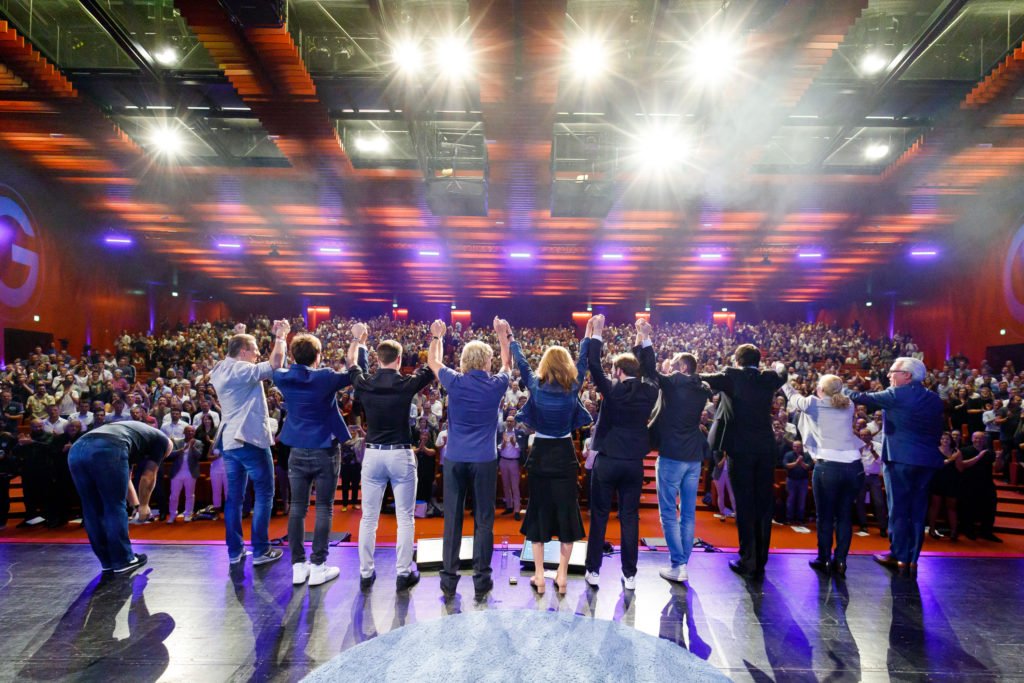
For some years now, more and more people have been looking for their way onto the big stage. However, it can take several years before you take off as a professional speaker and give your first talk. Especially speaking beginners ask themselves again and again questions like:
In order to make your presentations, whether you are a beginner or a professional, more successful in the future, we have provided you in this article with a total of 5 tried and tested tips prepared for your next Keynote can use.
You will see that the ideas from this article will help you to have more stage presence and a better effect on your audience. So, if you have to give a presentation soon, it will definitely be a great success.
In addition, you can get here our free workbook "Keynote Presentation downloadwith the help of which you can create your first Develop Keynote or an existing presentation improve you can.
No matter how good the content of your keynote is, if you mess up the introduction, you might lose the audience's interest right from the start of your presentation. Therefore, there are some tricks you can use to make the introduction more exciting and interesting.
Especially the first 10 seconds of your presentation decide whether your keynote will be a success. With innovative entrances you directly gain attention of the audience and build up tension:
"Did you know? Already in 20 years the Climate Change be responsible for numerous natural disasters. If we want to save the planet, we must take the initiative now."
Also rhetorical questions can be a good, first start:
"Are you tired of your Fears determine your life? Wouldn't you much rather become the designer of your life and determine your own destiny?"
Or you start with personal experiencesthat at the same time create a more personal connection between you and the audience:
"Just three years ago, I couldn't pay the rent on my apartment by myself. I was penniless and torn apart inside. How to find the way out of my Life crisis I'd like to reveal to you today."
In addition to the 10-second rule, you should also keep in mind that a good presentation consists primarily of InfotainmentThis is the right combination of entertainment and information. Contemporary speakers in particular rely on infotainment when giving presentations, because this is the best way to pick up the audience and create excitement.
But to make sure you don't lose the attention of your audience during your keynote, you can unforeseen plot twists and moments of surprise can be a real magic bullet. For example, you can give an unexpected twist to an obvious story or mirror a seemingly personal story to the audience so that they recognize themselves in it.
Have you ever used surprise moments in your presentations? Then tell us your favorites in the comments below this article.
When giving a presentation, many speakers tend to ramble on. During their presentation, they jump from topic to topic and lose sight of the actual core message. The result: the listener no longer follows along and loses interest in you and your presentation. Therefore, you should always keep an eye on the red thread that leads to your actual core message.
You can do this best with a good keynote architecture. When giving a presentation, you can use numerous methods that have proven themselves in practice as a guide.
One of them is the KAUB formula. This is particularly well suited for beginners who want to gain their first experience as a keynote speaker. The KAUB formula consists of four individual parts: The Contact phase, attention phase, instruction and affirmation.
In addition to a good, structural structure of your presentation, you should not forget the interests of your audience. People attend lectures and seminars because they want to get an personal benefit for one's own life from it. Conversely, this means that your audience should not only be able to follow you thematically, but should also take key messages from your presentation.
Therefore, instead of trying to distinguish yourself with your own successes during the presentation, as a good speaker you should address the problems of the audience and present possible solutions.
Giving a talk is like taking your audience on a journey. On this journey, your audience wants to Experience feelings and not be fed exclusively with dry information. Therefore, avoid at all costs to design your keynote like a university lecture.
Because the drier your presentation, the faster you lose the attention of your audience. And that is the absolute horror scenario for every speaker. That's why it's essential that your keynote includes emotional elements to keep the attention of your audience.
Personal stories and anecdotes can further support your keynote by making your messages more tangible as you deliver them and help your audience better identify with the content. Your stories and anecdotes can be anything: emotional, exciting, scary, personal, sad etc. The main thing is that they underline the core message and the topic of your presentation and illustrate your words.
Particularly popular, for example, are also "Zero-To-Hero Stories" in which a person or group makes their way from difficult circumstances to success as they build excitement and inspire compassion.

The times when the speaker stood monotonously at the lectern and simply rattled off his content are long gone. Nowadays, the audience expects more - and you should definitely address this in your presentation. We would now like to tell you what options you have to do this:
Also Join-in exercises are a powerful tool to engage your audience when giving a talk.
Lastly, one thing in particular is important during your presentation: Your Energy level hold up. Nowadays, a modern speaker resembles more and more an entertainer.
The latter is always characterized by a high energy level.
That's why it's also important for you as a speaker to have a high energy level when giving a talk, which helps to engage your audience. Here 3 short tipshow to get more power on stage:
Authenticity is the key to success. The audience immediately notices whether you are genuine or pretending. Therefore, stay true to your line and try to convince the audience of you in a natural way.
If you are truly authentic, people will remember you and they will remember your individuality. And that, in turn, will make you stand out from the gray mass of the average. So as soon as you have to give your next presentation, be sure to pay special attention to the following things:
Last but not least, not a tip, but an absolute must: Practice, practice, practice!
No master has yet fallen from the sky, because even top speakers like Tobias Beck, Dr. Stefan Frädrich or Michael Rossié always take enough time to prepare their speeches. When they give a talk, leave they nothing to chance.
Your goal should always be a Stage performance that will be remembered. And that's why it's also true for you: Practice until the keynote sits! If you're still unsure about how to properly set up your keynote, then download now here our free keynote workbook down.
In this article, we have presented you 5 valuable tips that you can use to improve the quality of your keynote. With the tips from this article, you will be able to captivate your audience and add more value with your keynote.
Which of the tips did you like best? Do you have any other tips that you use on stage that work particularly well? When you have to give a talk, what do you pay special attention to? Feel free to share your ideas with us in the comments. We'd love to hear any other suggestions you have.

